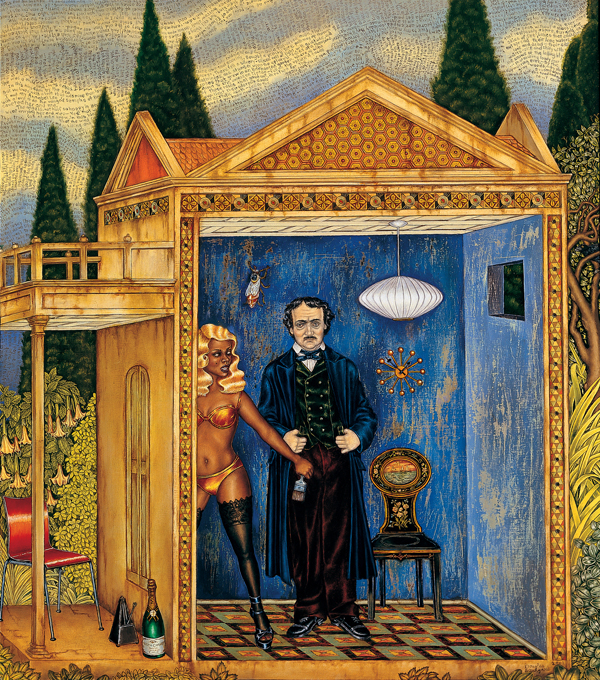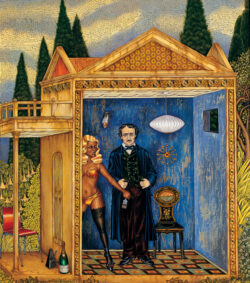Douglas Bourgeois
Douglas Bourgeois is a Louisiana painter, collage artist, and sculptor known for his intimately scaled, highly detailed, and meticulously crafted works.

Courtesy of Arthur Roger Gallery
Kim and Ed- The Remix. Bourgeois, Douglas (Artist)
Touglas Bourgeois, a painter, collage artist, and sculptor known for his intimately scaled, highly detailed, and meticulously crafted works, is among the Louisiana painters New Orleans critic D. Eric Bookhardt dubbed the “Visionary Imagist” artists. Major and recurring subjects in his narrative paintings include religious figures and iconography (largely Catholic), movie stars, pop musicians, social and political issues (including race and class), the endangered natural environment, and the signs and symbols of America’s popular culture (including its advertising and commercial products). Bourgeois has stated that “people refer to my paintings as narrative.…Not only do people expect this of me, but I can’t help it. It’s my southern storytelling tradition.” Bourgeois lives and works in Ascension Parish, Louisiana, in St. Amant, where he was raised.
Bourgeois has long been regarded as a leading artist in Louisiana and in the South. In 1990, critic Roger Green, in ARTnews, discussed the Visionary Imagists and concluded that “the outstanding talent in the group is 39-year-old Douglas Bourgeois, whose paintings and painted shadowbox-like constructions are minor miracles in a fastidious realist technique.” That same year, Bookhardt—who grouped Bourgeois, Jacqueline Bishop, George Febres, Ann Hornback, and Dona Lief as the Visionary Imagists—described Bourgeois as “a product of his Cajun heritage” and a creator of figures in his “gem-like paintings [who] are largely derived from what might be called rhythm & blues sociology.” Continuing, he noted, “Most Visionary Imagism (with the partial exception of Douglas Bourgeois) does not deal specifically with regional themes.…Visionary Imagist artists deal mostly with social, psychological, and environmental issues.” Later, in 2004, Isabelle Loring Wallace, writing in Art in America, described Bourgeois as “Louisiana’s leading fantasy-based realist painter,” and after referring to his association with the Visionary Imagists, concluded that his work “both reflects and transcends this regional kinship.”
Bourgeois was born in 1951, the oldest of six children in a Louisiana Catholic family. He was raised on a fourteen-acre family farm. His father operated a local barbershop and was a sign painter. “He was very good with brushes,” Bourgeois recalled, adding, ”Our first playing with paint was using his sign-painting brushes.” While he grew up in a small town in Cajun country, Bourgeois’s life was far from remote or isolated, reflecting an awareness of larger American issues through television, radio, magazines, movies, and popular music in the 1950s and 1960s. He attended St. Teresa of Avila Catholic School in Gonzales from grades three through eight. From ages nine to fourteen, he was an altar boy, then at age fourteen he entered St. Joseph Cathedral Preparatory Seminary in Baton Rouge, intending to become a priest.
Studying for the priesthood immersed Bourgeois deeply in Catholicism, including its iconography, saints, liturgy, and rituals. He described himself as “a teenage mystic” in those years. In this period he also developed a growing interest in America’s popular culture, especially its movies and music. Growing up, his family did not attend art museums, but he found art reproductions in magazines (including Life and Look at his father’s barbershop), Catholic church statues and stained glass windows, and original paintings and murals by Dom Gregory de Witt, a noted Louisiana artist who decorated Catholic churches. During his senior year, Bourgeois decided to leave the seminary, abandoning his goal of becoming a priest, and enrolled at the public high school in Gonzales.
In 1969, at the height of the Vietnam War and the counterculture movement, Bourgeois enrolled at Louisiana State University (LSU) in Baton Rouge as an English major. Dissatisfied, he dropped out, then returned in 1971 as an art major, determined to become a painter. LSU’s art department was staffed by a faculty of noted artists, including Robert Warrens (a mentor of Bourgeois), Michael Crespo, and Ed Pramuk. After completing his art degree in 1974, Bourgeois worked numerous day jobs in Baton Rouge, such as clerking in the basement of a government building and various food service positions, and painted at night. One of his early paintings, inspired by listening to Etta James, was Little Etta (1974), which he considers his first pop painting.
In 1975, he painted Ava with Burning Cheeks, depicting actress Ava Gardner, and thus began his focus on movie stars. He moved to New Orleans that year, worked in diverse jobs, and immersed himself in New Orleans culture, becoming friends with artists including George Febres. In 1978, he painted works reflecting his Catholic background, such as The Temptation of Brother Michael, and initiated a series of religious apparition paintings with Blessed Virgin Appears to a Woman. This was followed by works including St. Anthony Appears to Tony (1989) and The Kitchen (1990) and other religious images such as Setchie as St. Francis (1983), The Temptation of St. Rose of Lima (1990), and Daily Cross (1997). He also found inspiration in postcards, toys, children’s books, and celebrity biographies, and began a series of paintings inspired by high school yearbooks, including Twilight High Yearbook (1978).
Around 1980, determined to become a professional artist, Bourgeois sought a quieter place than New Orleans, and returned to St. Amant, where he used his father’s workshop as an art studio. There he listened to records, watched television, read celebrity biographies, and created art inspired by these interests. He began to paint Elvis Presley, in Blue Christmas (1981) and Elvis and Dice Curtains (1981), and later in A New Place to Dwell (1987). Influenced by an understanding of religious iconography, holy cards, and the history of art, he treated his subjects as kings and queens, especially figures like Elvis and Aretha Franklin, whom he painted in Aretha, Mysterious Lady of Sorrow (1981), and in Mystical Anthem (1988).
In 1981 Bourgeois received regional and national recognition when he was given an Awards in the Visual Arts Fellowship from the Southeastern Center for Contemporary Art in Winston-Salem, North Carolina. That same year his work was shown (and later collected by) the National Museum of American Art in Washington, D.C. This made him consider the fleeting nature of fame and led to a series of paintings, from about 1981 to 1985, that focused on musical celebrities such as Little Eva and Tammi Terrell, writers such as Sylvia Plath, and actresses such as Inger Stevens. In 1986 his focus shifted, and he created a series of sculptures and box pieces, inspired by Joseph Cornell, including Ball of Confusion (1986), Alien Cabaret (1988), and a pair of works, The Little Child Inside, I and II (1988).
During the late 1980s and early 1990s, Bourgeois’s subject matter came from multiple sources, including musicians (Aretha Franklin, Queen Latifah, and others), and his work reflected an emerging interest in social issues, including crime, domestic violence, homelessness, and the environment. Scapegoat Cabaret (1991) was a response to David Duke’s campaign for governor of Louisiana, and Mistaken Identity (1991) addressed issues of race and class in the United States. In a diverse range of paintings, Bourgeois addressed other issues, including domestic abuse in Out of Here (1995), poverty and homelessness in Change of Address (1996), and media scrutiny and intrusiveness in Under the Lens (1995).
Threats to the environment have became one of Bourgeois’s major concerns in his latest works of art. Suburban sprawl and expanding highways, pollution, and the misuse of natural resources, including the realities evident to Bourgeois in Louisiana’s chemical corridor between New Orleans and Baton Rouge, continue to inform his art. This is evident in paintings such as Nightflame (1988), Woman from St. Gabriel (1991), The Development (1993), Dreaming of Home (1993), The Traveler (1993), Chlorophyll Pulse (2000), and Aperture (2001).
Bourgeois’s works have been featured in an ongoing series of exhibitions at the Arthur Roger Gallery in New Orleans, and in a range of museums. Increasingly, art museums and private collectors have acquired his works, and they have been featured in exhibitions and collections at the two national museums devoted to Southern art, the Ogden Museum of Southern Art in New Orleans and the Morris Museum of Art in Augusta, Georgia. In 2003 and 2004, Bourgeois was the subject of a major traveling exhibition and accompanying catalogue, Baby-Boom Daydreams, The Art of Douglas Bourgeois, organized by the Contemporary Arts Center in New Orleans.
In 2005, after Hurricane Katrina struck New Orleans and the Gulf Coast, followed by Hurricane Rita, which struck Acadiana and Southwestern Louisiana, Bourgeois refocused his efforts, and as recovery advanced, he presented two notable exhibitions at the Arthur Roger Gallery in 2006 and 2008. He also created the poster for the 2008 New Orleans Jazz & Heritage Festival, featuring singer Irma Thomas, a performer Bourgeois had long admired and who had evacuated to Gonzales, near his home, during Katrina. In 2011, Bourgeois was a featured artist in the Contemporary Arts Center’s thirty-fifth anniversary exhibition, Then and Now. Bourgeois’s art is included in the collections of the Ogden Museum of Southern Art, the Historic New Orleans Collection, the New Orleans Museum of Art, the National Museum of American Art in Washington, D.C., the Morris Museum of Art, and the Southeastern Center for Contemporary Art in Winston-Salem, North Carolina.
